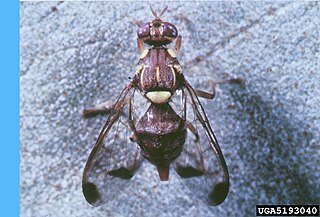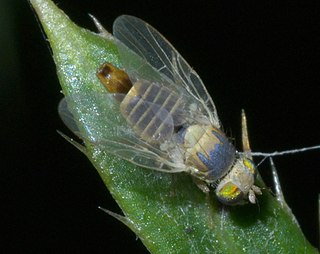
Centaurea is a genus of between 350 and 600 species of herbaceous thistle-like flowering plants in the family Asteraceae. Members of the genus are found only north of the equator, mostly in the Eastern Hemisphere; the Middle East and surrounding regions are particularly species-rich. In the western United States, yellow starthistles are an invasive species. Around the year 1850, seeds from the plant had arrived to the state of California. It is believed that those seeds came from South America.

The apple maggot, also known as the railroad worm, is a species of fruit fly, and a pest of several types of fruits, mainly apples. This species evolved about 150 years ago through a sympatric shift from the native host hawthorn to the domesticated apple species Malus domestica in the northeastern United States. This fly is believed to have been accidentally spread to the western United States from the endemic eastern United States region through contaminated apples at multiple points throughout the 20th century. The apple maggot uses Batesian mimicry as a method of defense, with coloration resembling that of the forelegs and pedipalps of a jumping spider.

The Tephritidae are one of two fly families referred to as fruit flies, the other family being the Drosophilidae. The family Tephritidae does not include the biological model organisms of the genus Drosophila, which is often called the "common fruit fly". Nearly 5,000 described species of tephritid fruit fly are categorized in almost 500 genera of the Tephritidae. Description, recategorization, and genetic analyses are constantly changing the taxonomy of this family. To distinguish them from the Drosophilidae, the Tephritidae are sometimes called peacock flies, in reference to their elaborate and colorful markings. The name comes from the Greek τεφρος, tephros, meaning "ash grey". They are found in all the biogeographic realms.

Centaurea calcitrapa is a species of flowering plant known by several common names, including red star-thistle and purple starthistle. It is native to Europe but is rarely found there, it is known across the globe as an introduced species and often a noxious weed. The species name calcitrapa comes from the word caltrop, a type of weapon covered in sharp spikes.

Centaurea solstitialis, the yellow star-thistle, is a member of the family Asteraceae, native to the Mediterranean Basin region. The plant is also known as golden starthistle, yellow cockspur and St. Barnaby's thistle The plant is a thorny winter annual species in the knapweed genus.
Chaetorellia acrolophi is a species of tephritid fruit fly known as the knapweed peacock fly. It is used as an agent of biological pest control against noxious knapweeds, especially spotted knapweed.
Bangasternus orientalis is a species of true weevil known as the yellow starthistle bud weevil. It is used as an agent of biological pest control against the noxious weed yellow starthistle.
Chaetorellia australis is a species of tephritid fruit fly known as the yellow starthistle peacock fly. It is used as an agent of biological pest control against the noxious weed yellow starthistle.

Larinus curtus is a species of true weevil known as the yellow starthistle flower weevil. It is native to Southern Italy, Southern Europe, the Middle East and the Caucasuses. It is used as an agent of biological pest control against the noxious weed yellow starthistle in the United States.

The melon fly(Bactrocera cucurbitae) is a fruit fly of the family Tephritidae. It is a serious agricultural pest, particularly in Hawaii.

Chaetorellia is a genus of tephritid or fruit flies in the family Tephritidae.

Terellia is a genus of tephritid or fruit flies in the family Tephritidae.

Urophora affinis is a species of tephritid or fruit flies in the genus Urophora of the family Tephritidae. It has been released in the United States and Canada as a biocontrol agent to control spotted knapweed. U. affinis became established in Montana in 1973.

Urophora jaceana is a species of tephritid or fruit flies in the genus Urophora of the family Tephritidae. The host plant for the larvae is usually black knapweed or Centaurea debeauxii.
Myopites inulaedyssentericae is a species of tephritid or fruit flies in the genus Myopites of the family Tephritidae.

Puccinia jaceae var. solstitialis is a species of fungus in the Pucciniaceae family. It is a plant pathogen that causes rust. Native to Eurasia, it is the first fungal pathogen approved in the United States as a biological control agent to curb the growth of the invasive weed yellow starthistle.
Larinus filiformis is a species of true weevil found in Armenia, Azerbaijan, Turkey, and Bulgaria.

Urophora stylata is a species of tephritid or fruit flies in the genus Urophora of the family Tephritidae. The host plant for the larvae is usually a thistle of genus Cirsium or Carduus.

Terelliini is a tribe of fruit flies in the family Tephritidae. There are at least six genera and about 104 described species in Terelliini.
Chaetorellia carthami is a species of tephritid or fruit flies in the genus Chaetorellia of the family Tephritidae.













